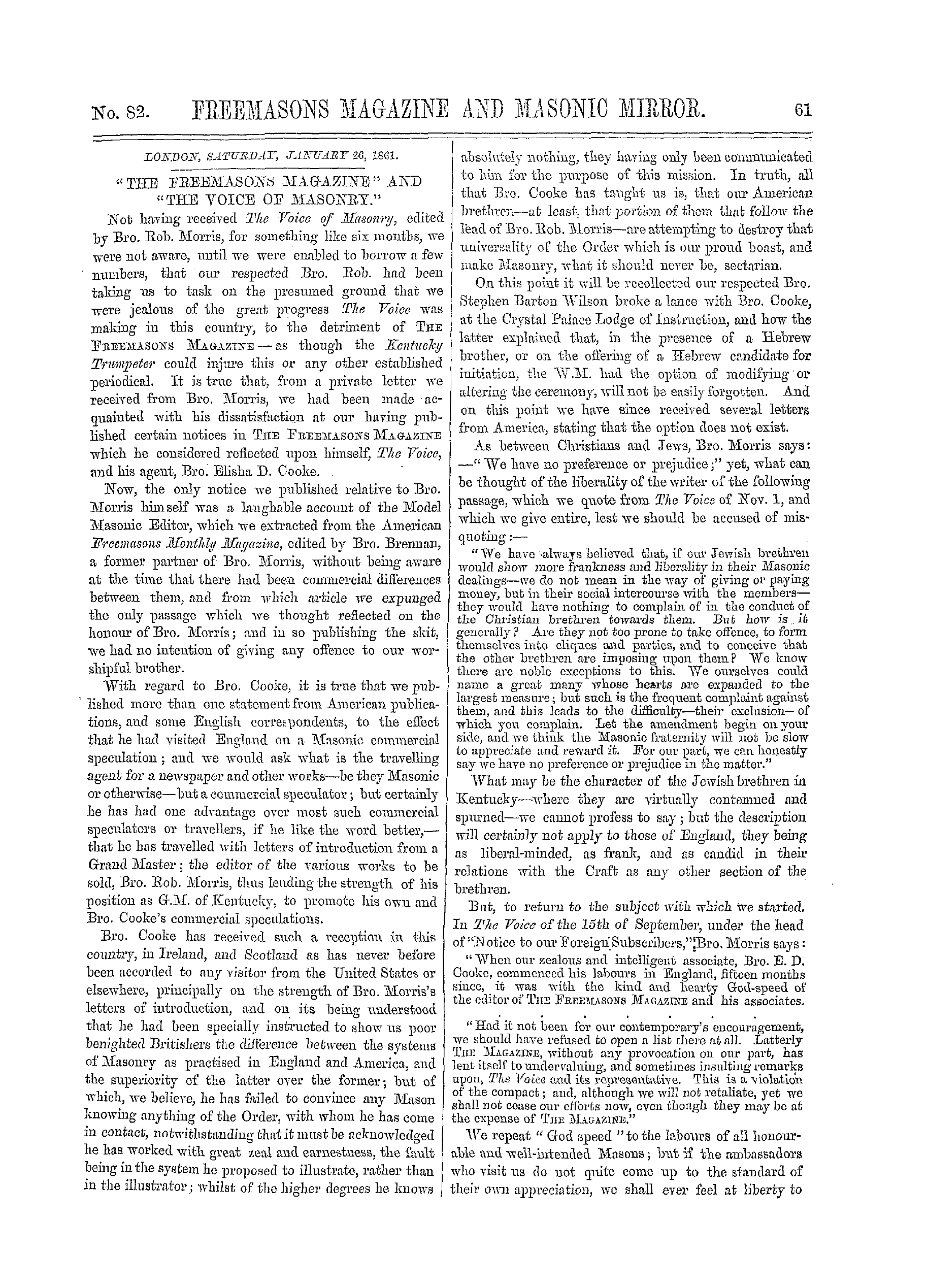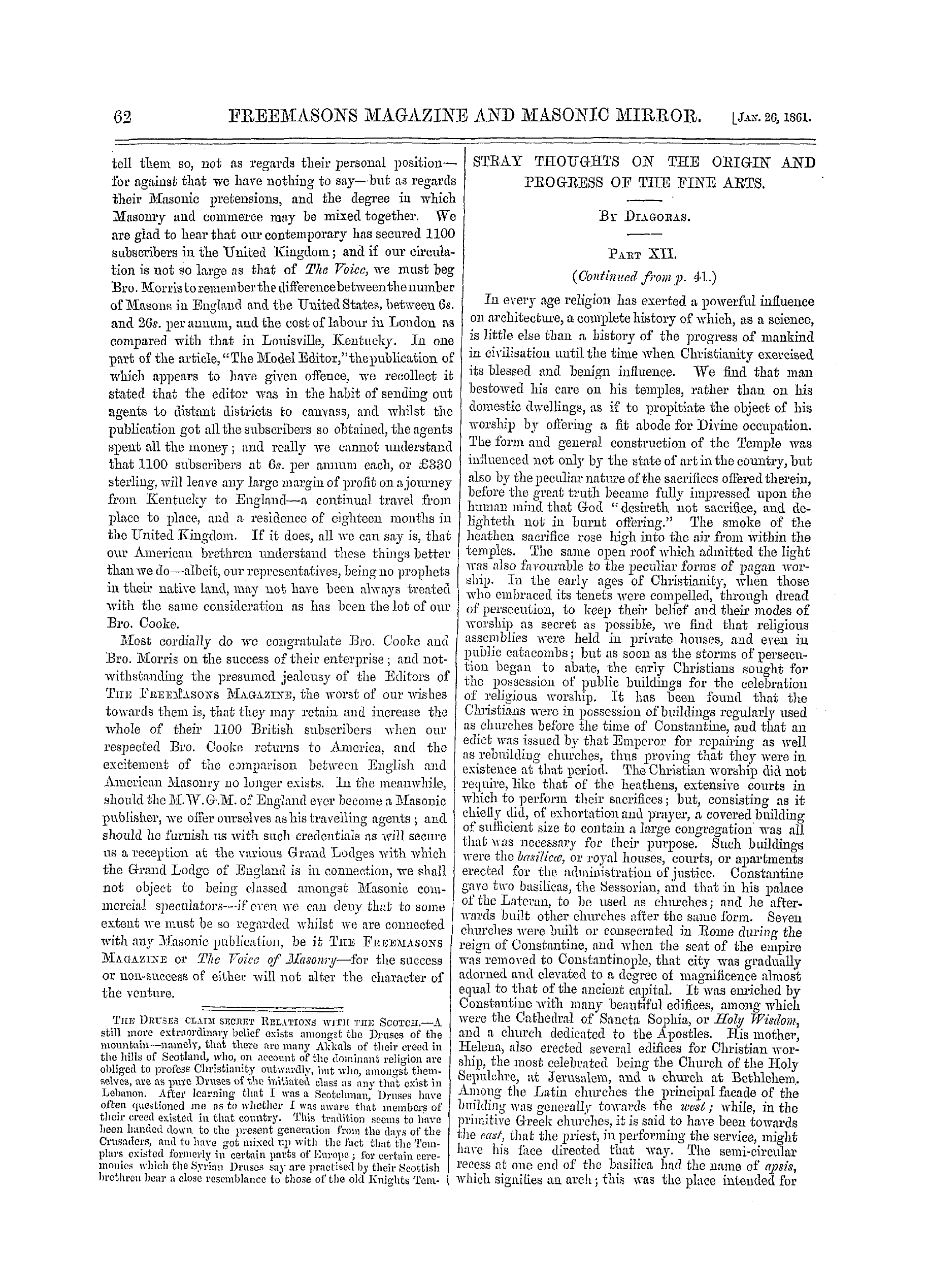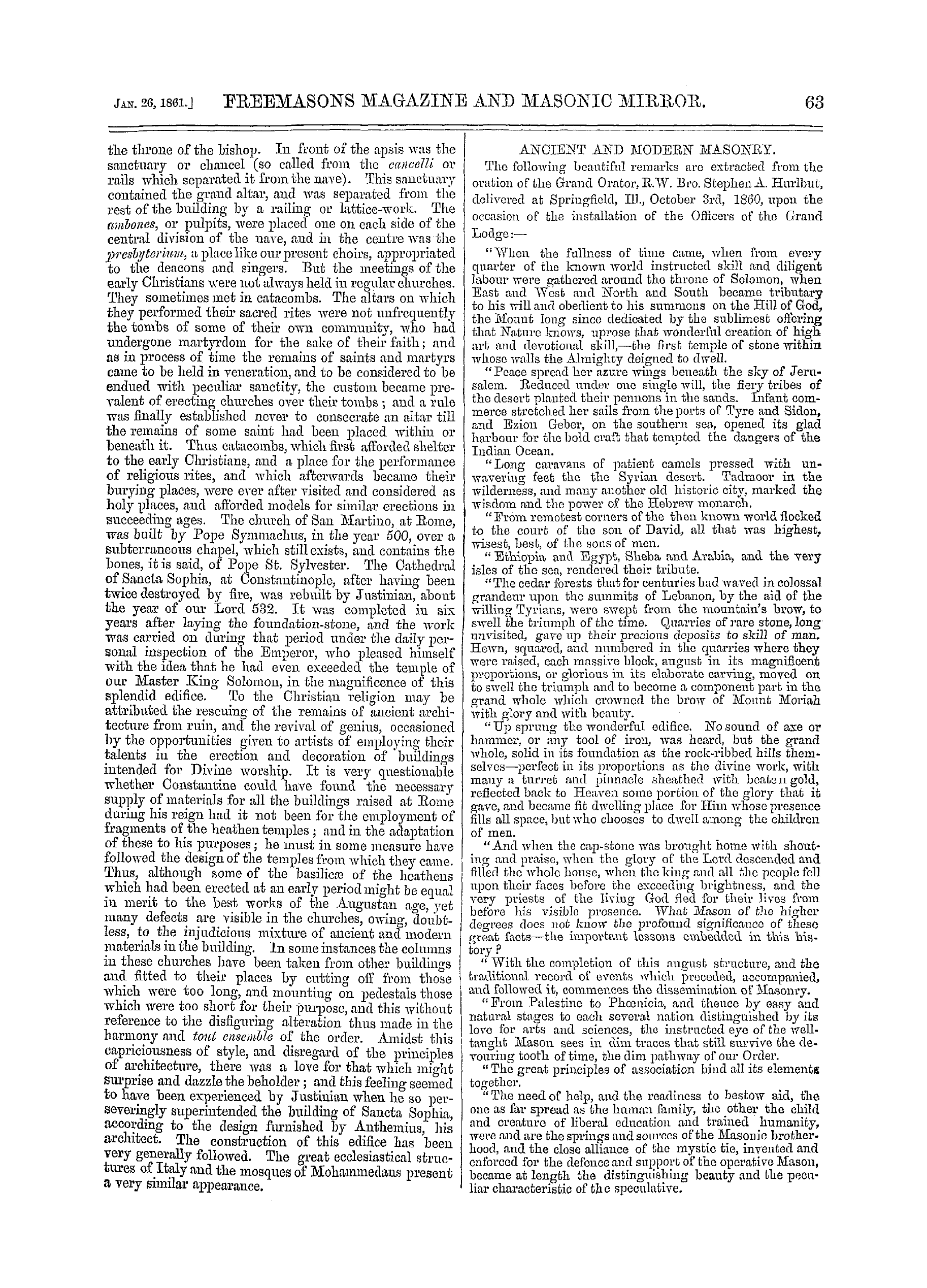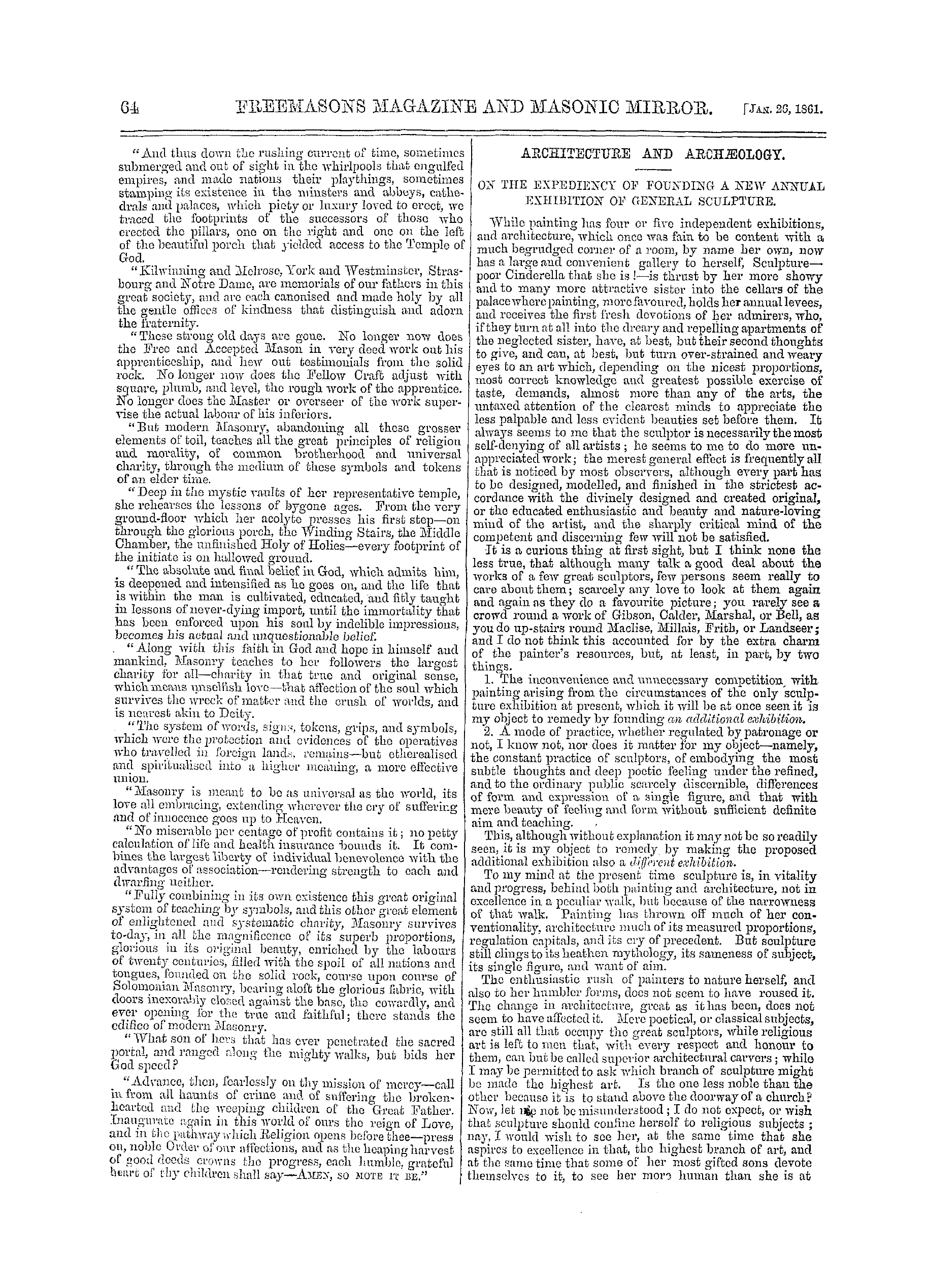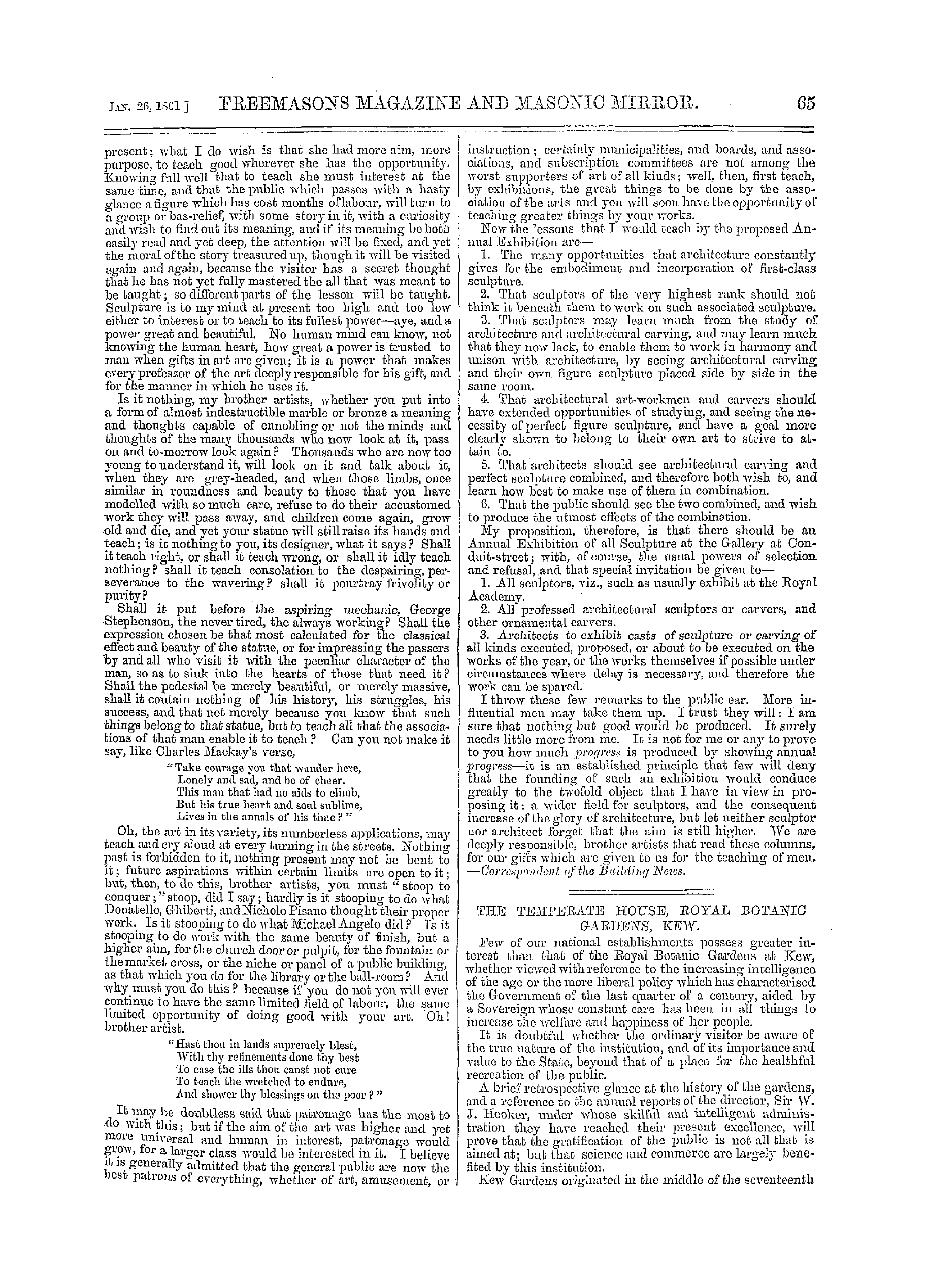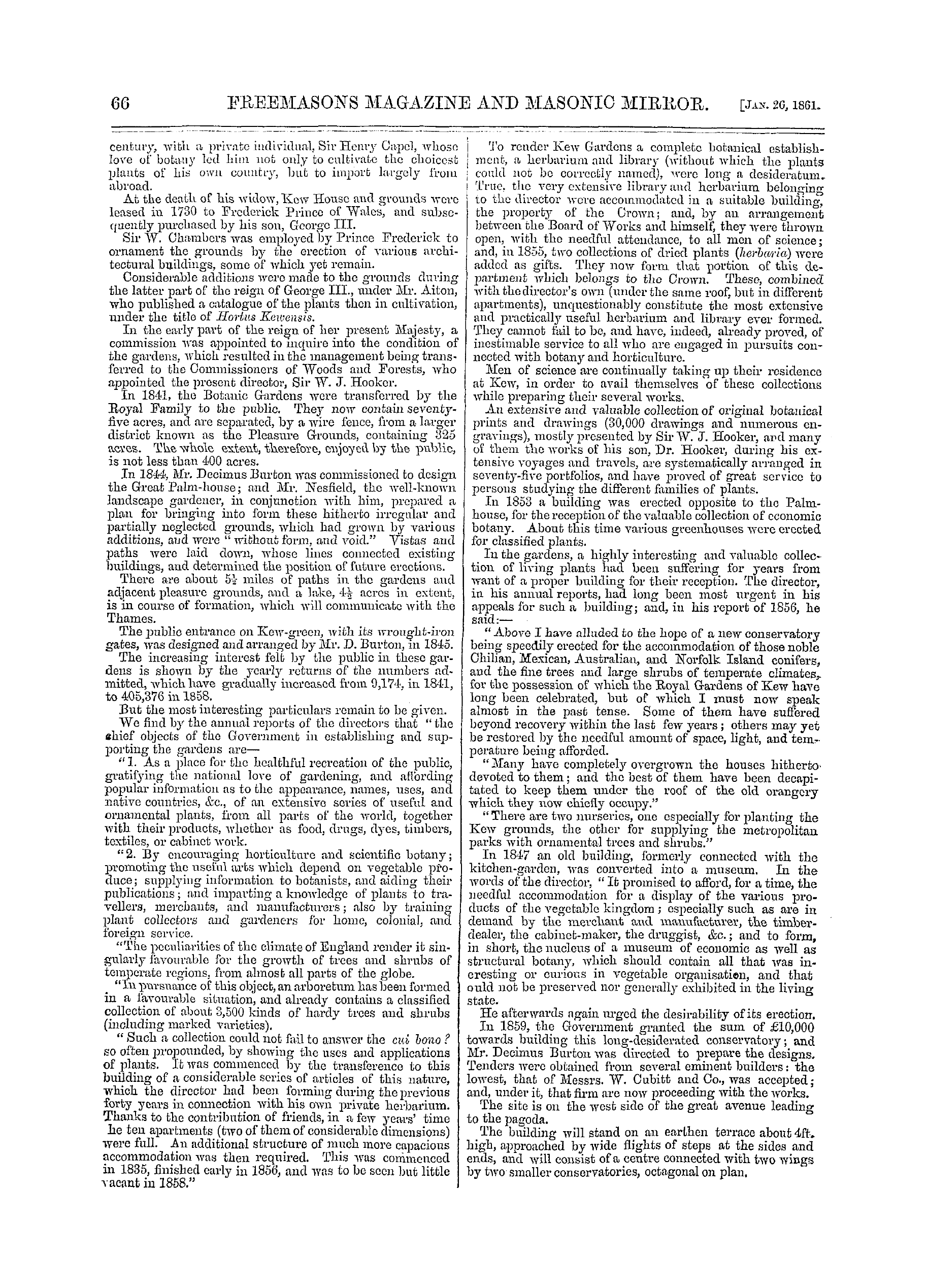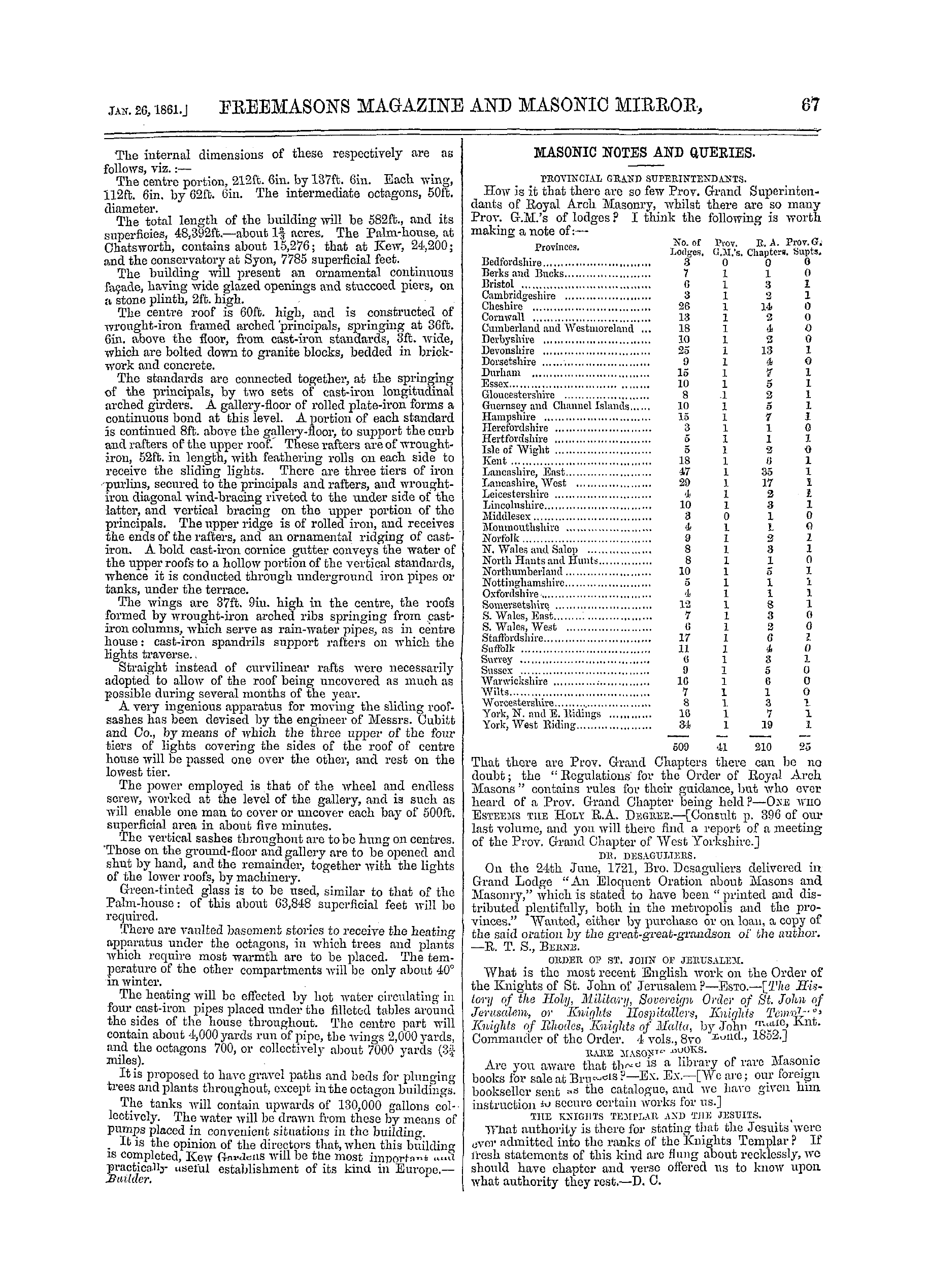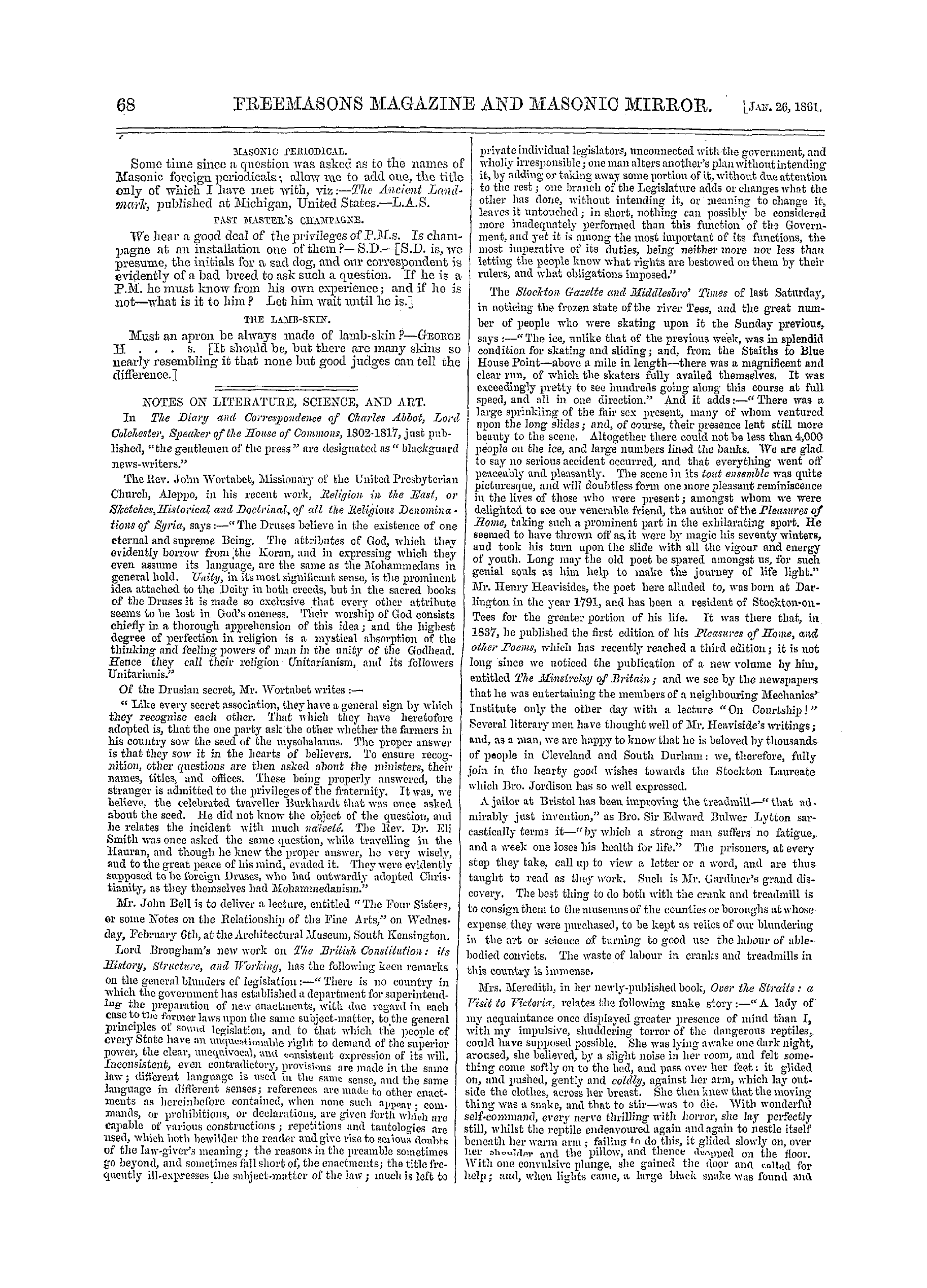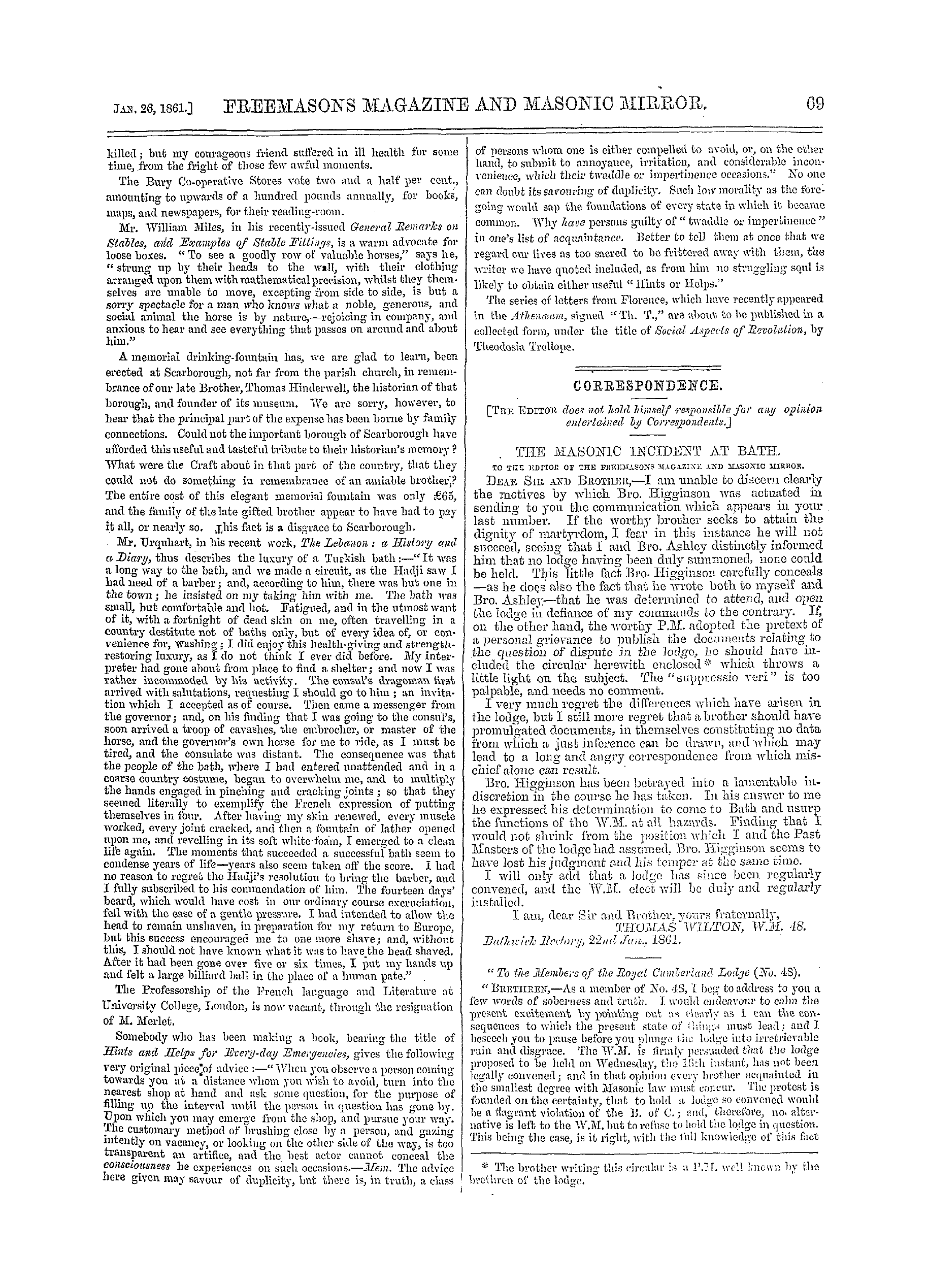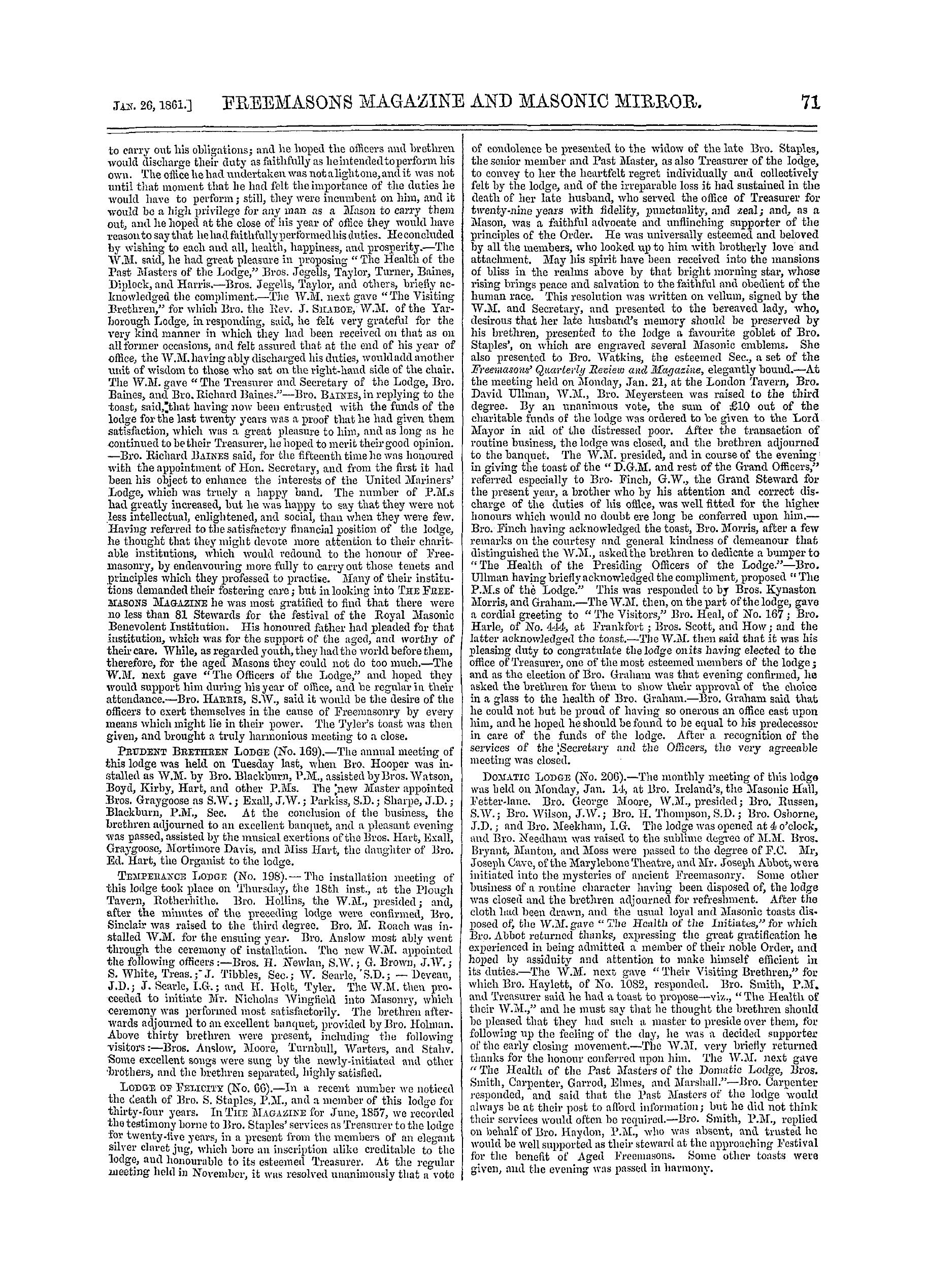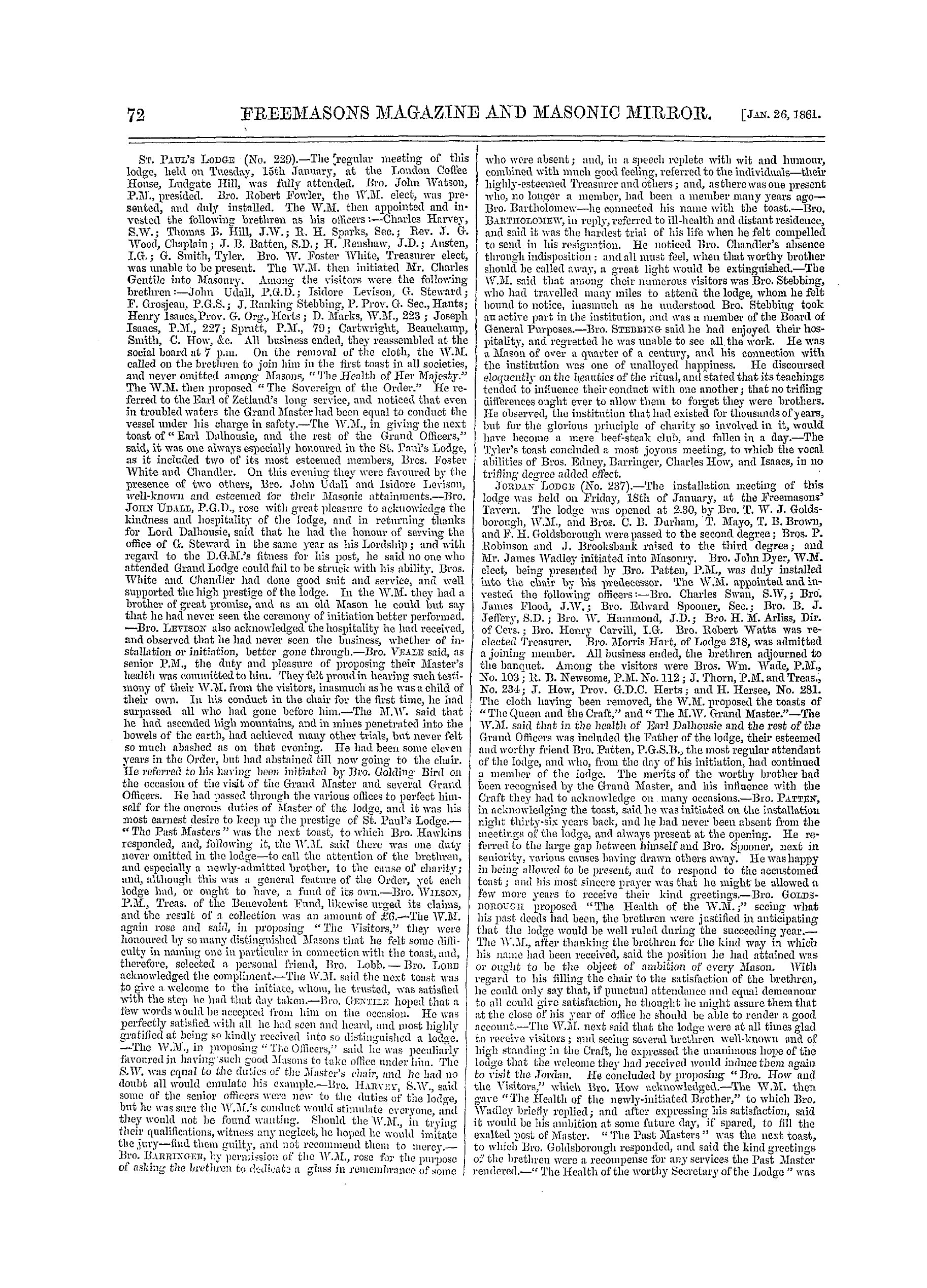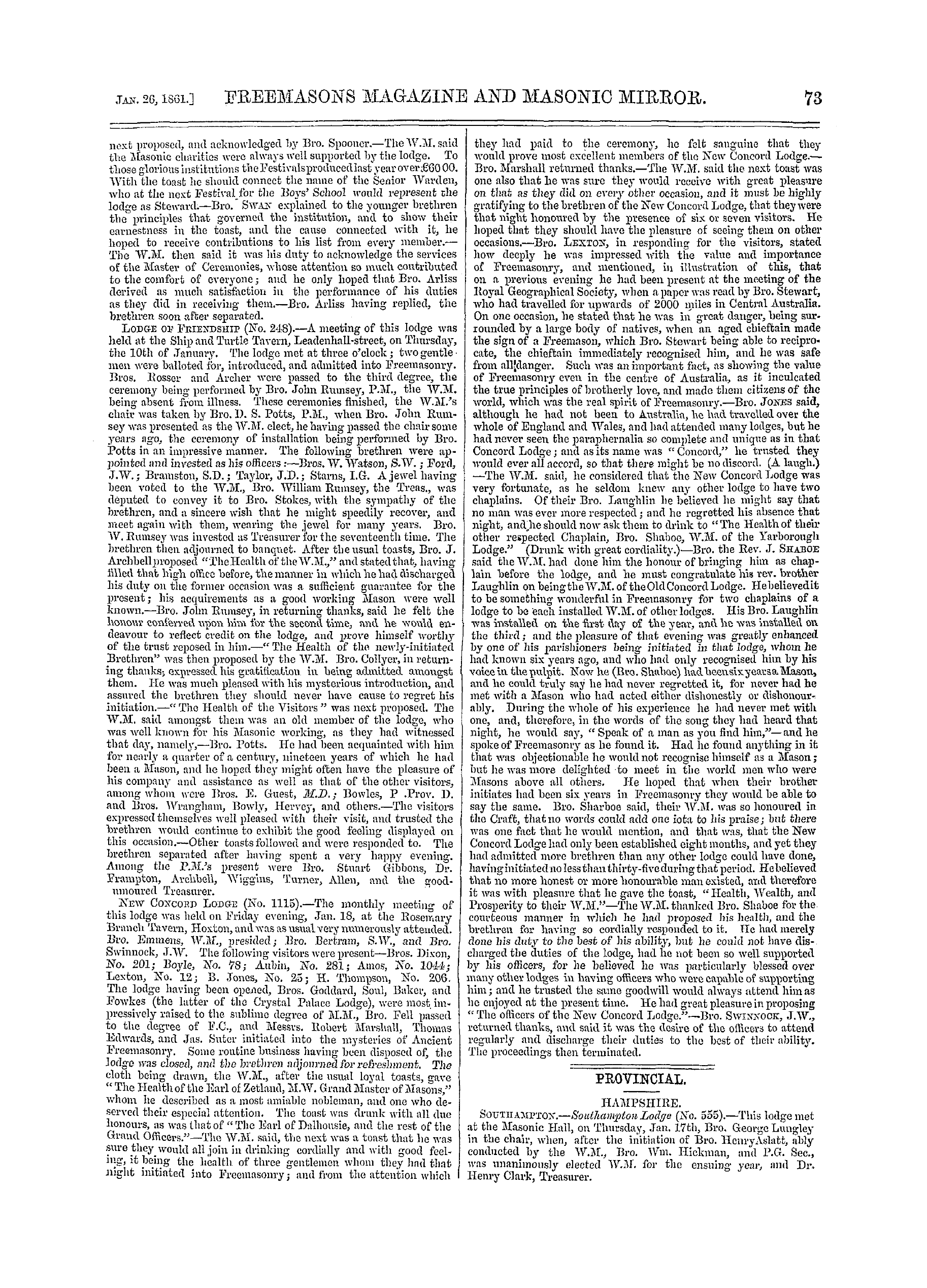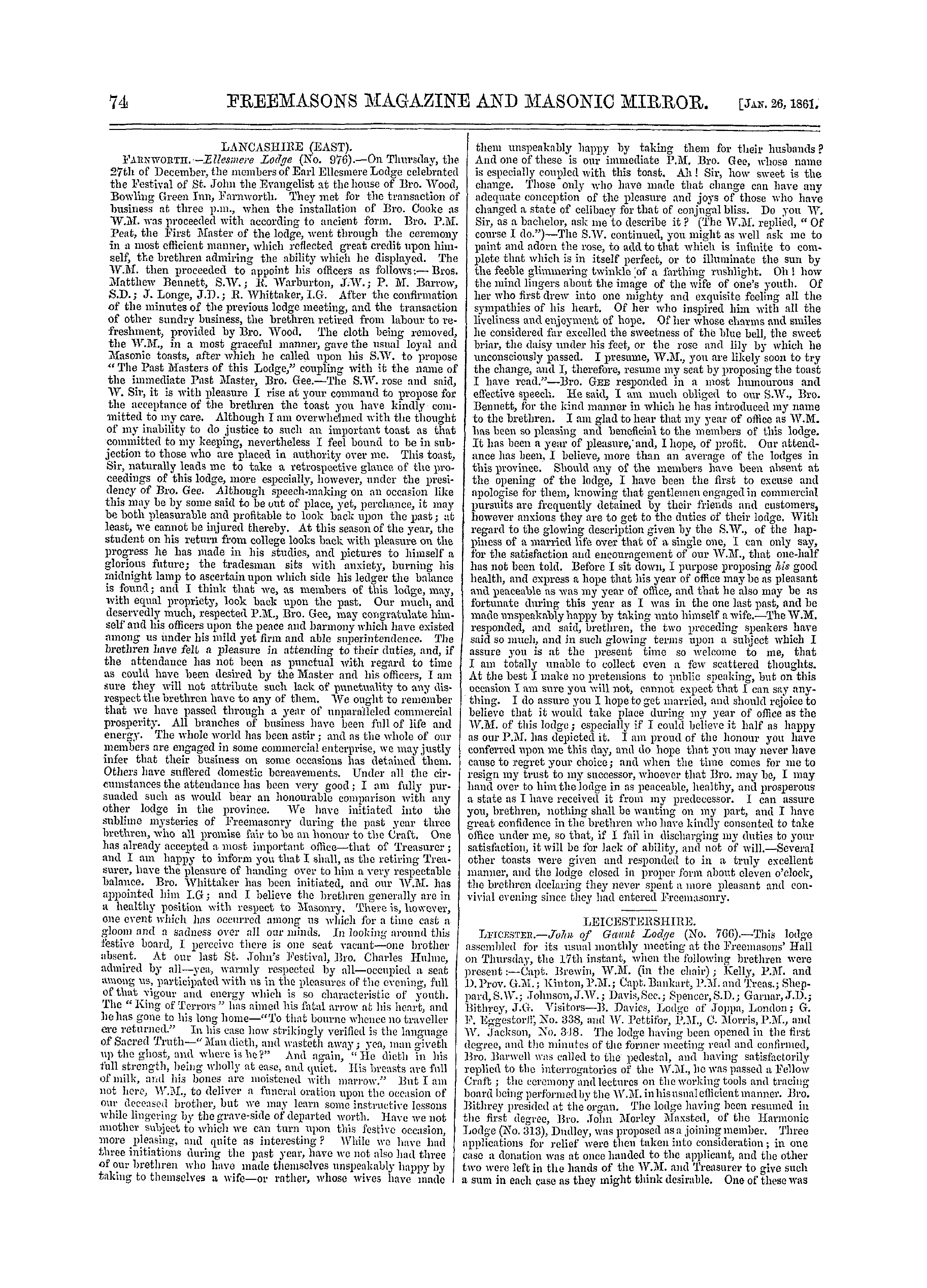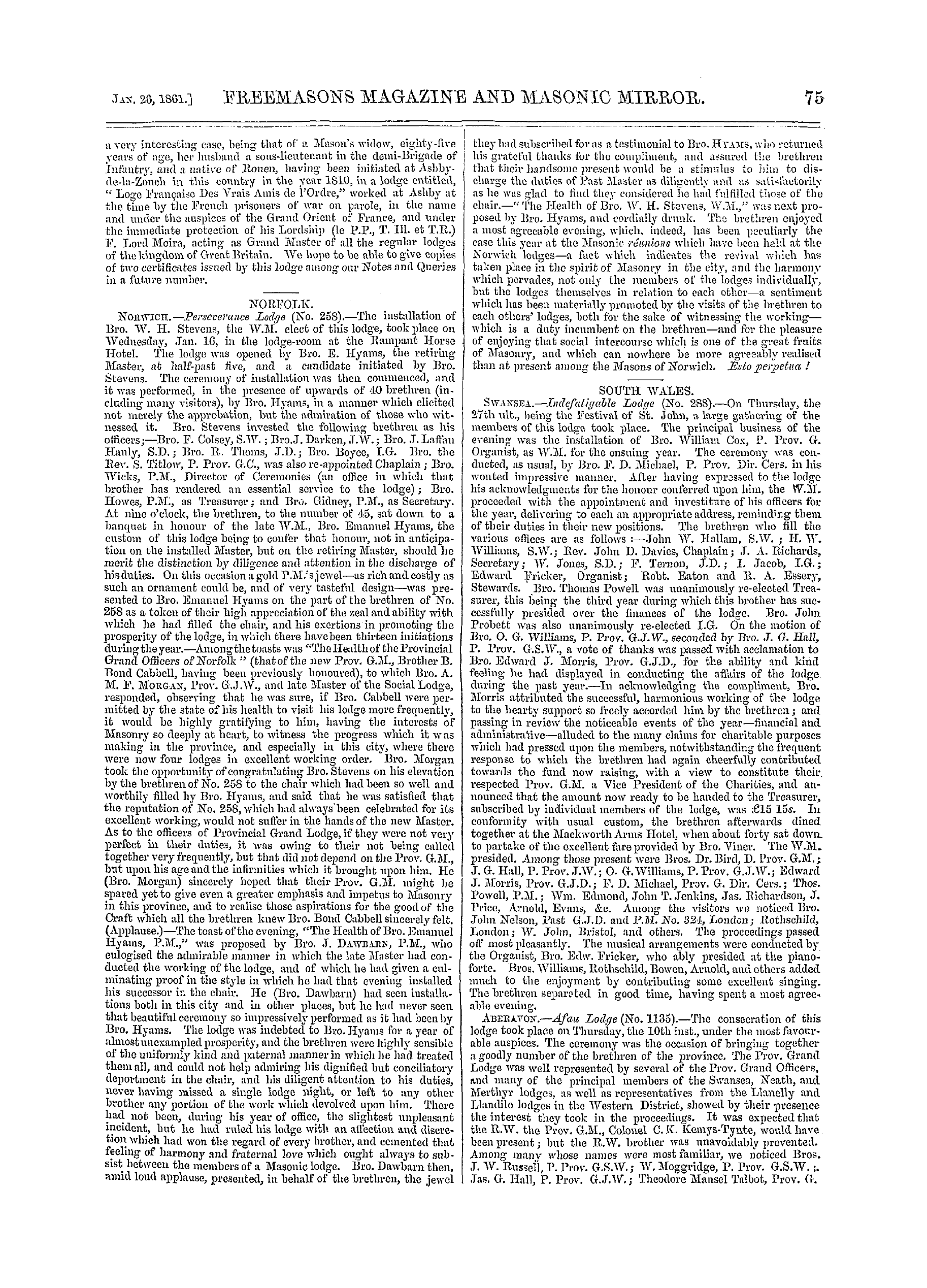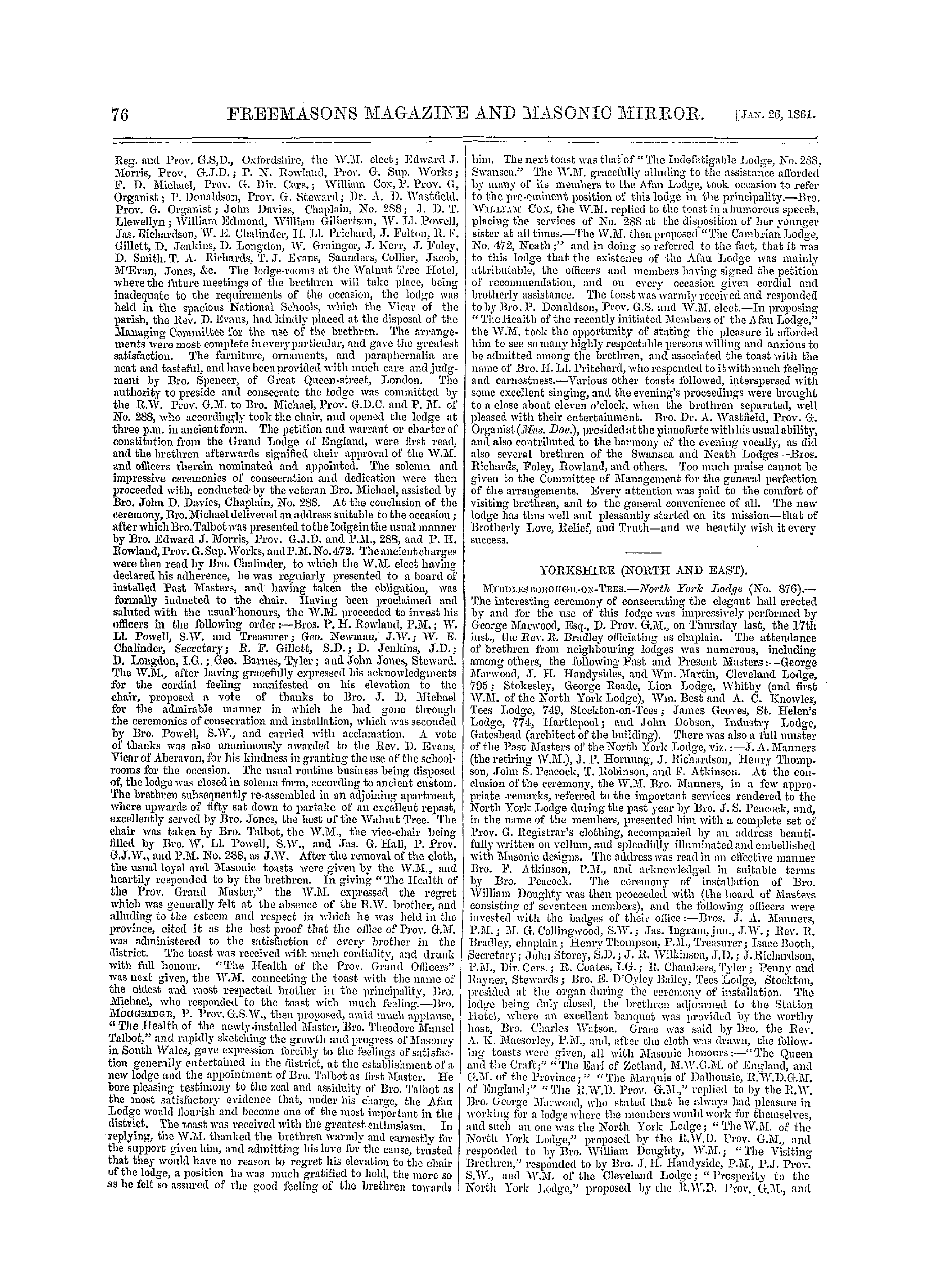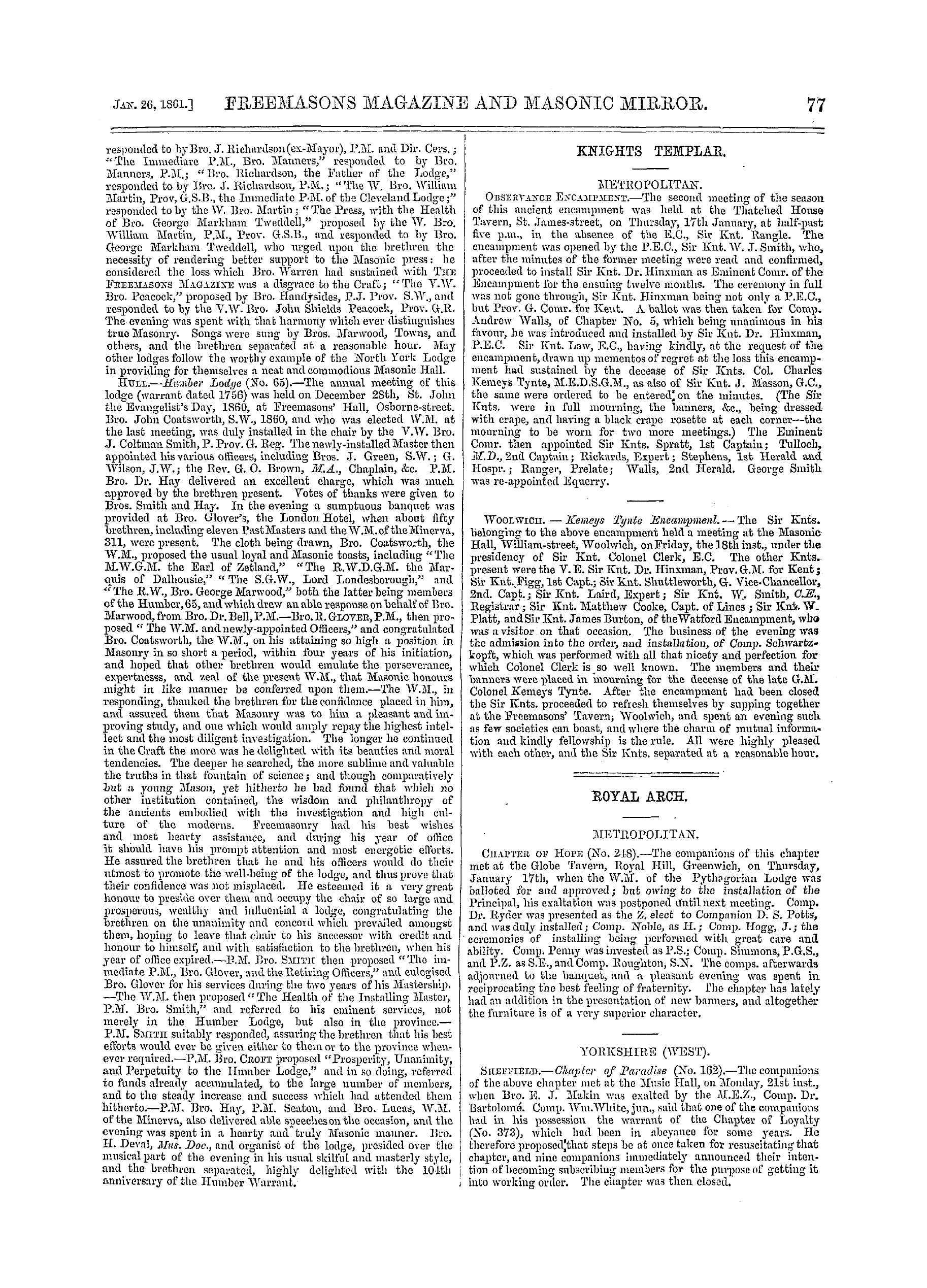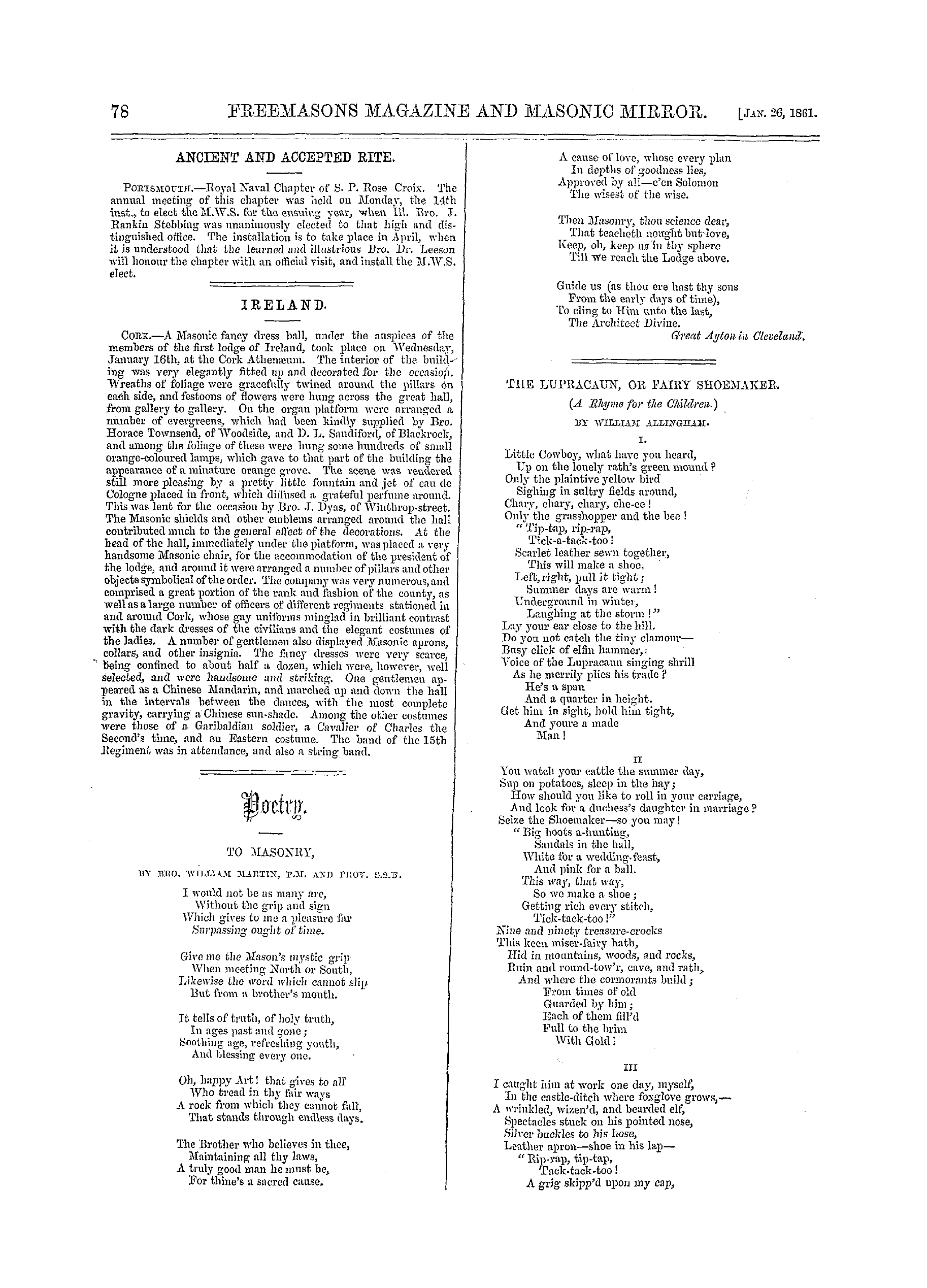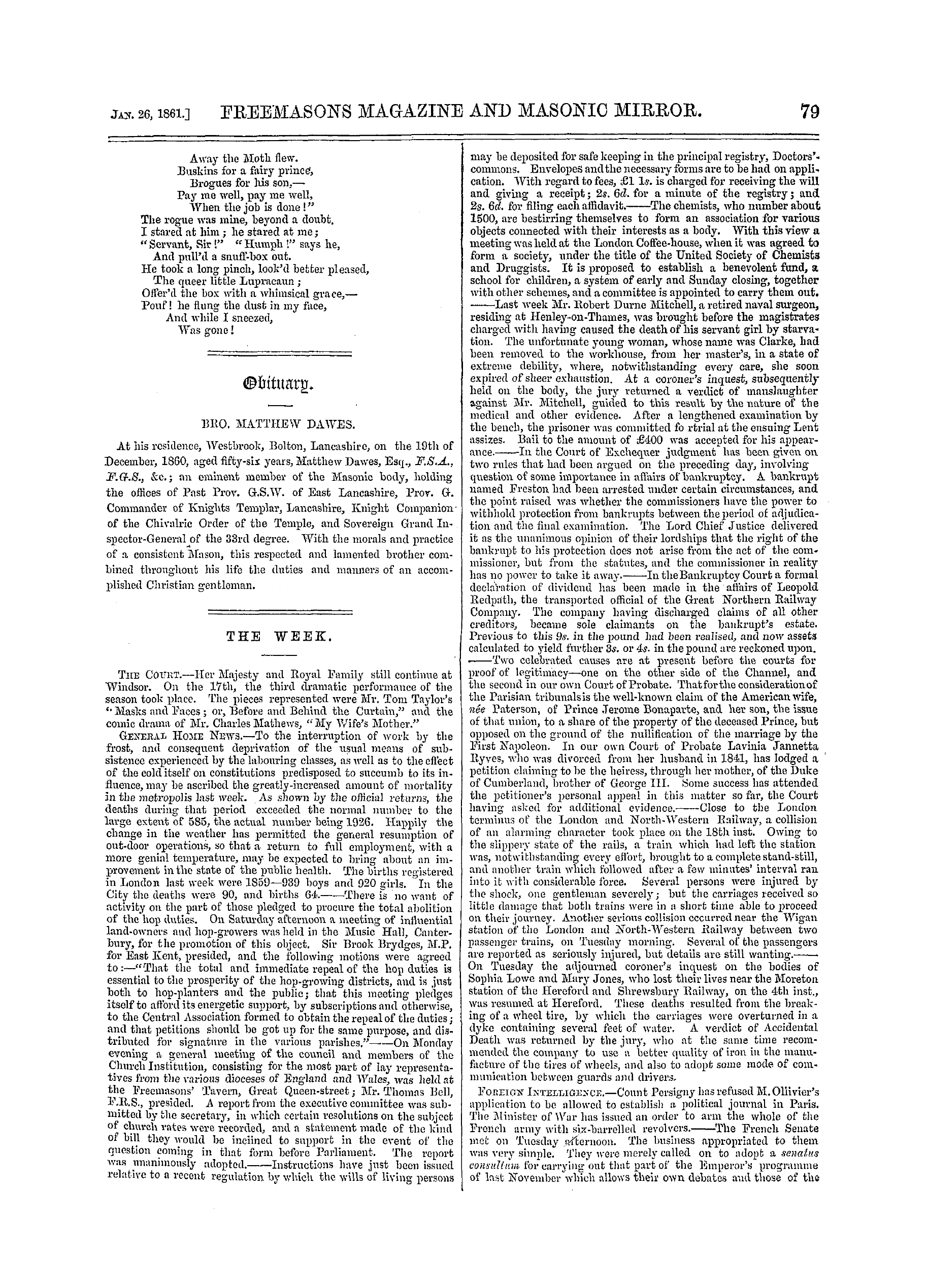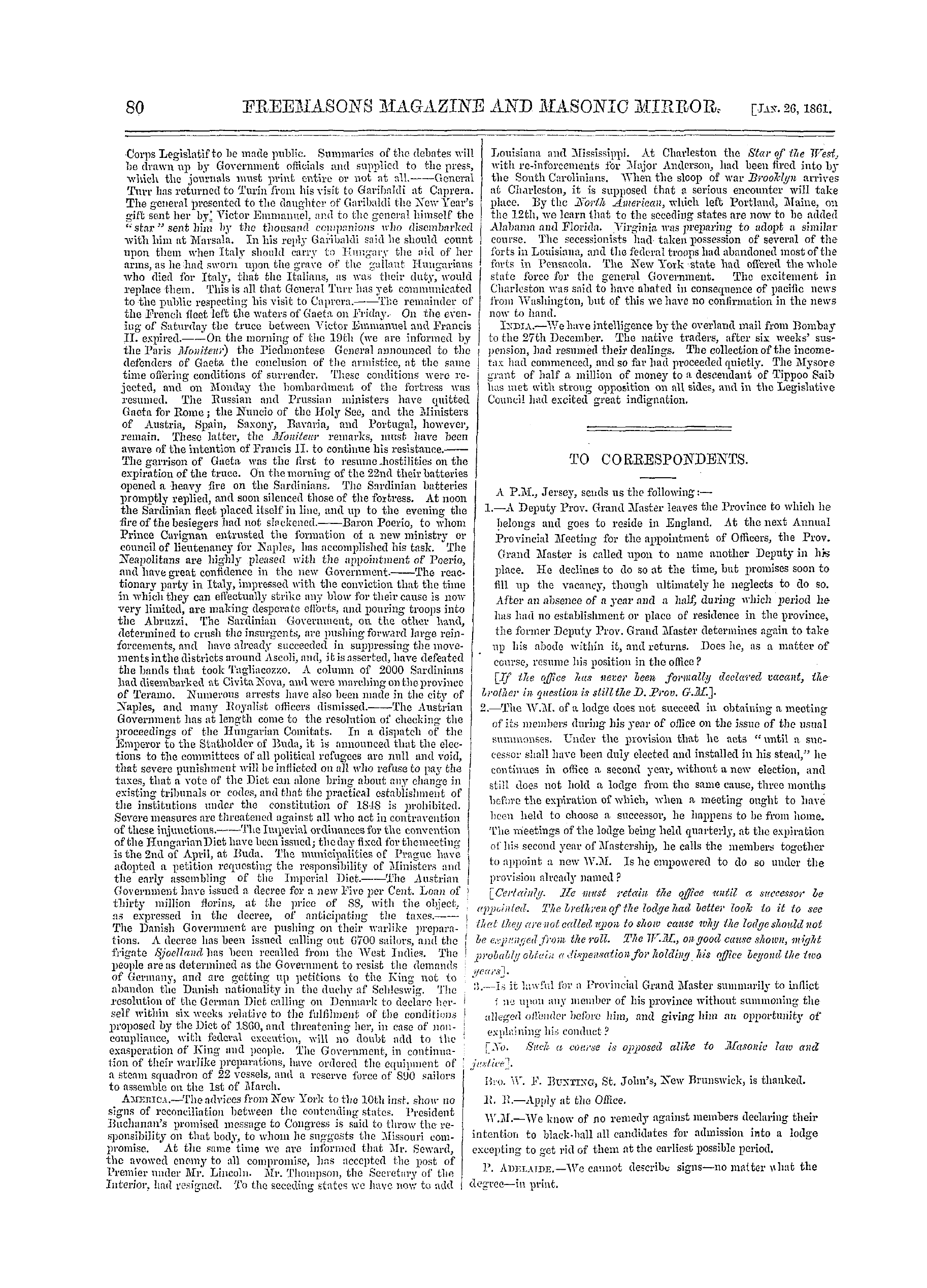-
Articles/Ads
Article ANCIENT AND MODERN MASONRY. ← Page 2 of 2 Article ARCHITECTURE AND ARCHÆOLOGY. Page 1 of 2 →
Note: This text has been automatically extracted via Optical Character Recognition (OCR) software.
Ancient And Modern Masonry.
" And thus down the rushing current of time , sometimes submerged and out of sight in tho whirlpools that engulfed empires , and made nations their playthings , sometimes stamping its existence in the minsters and abbeys , cathedrals and palaces , which piety or luxury loved to erect , we traced the footprints of the successors of those who erected the pillars , ono on tho right and one on the left of tho beautiful porch that yielded access to tho Temple of God .
"Kilwinning and Melrose , York and Westminster , Strasbourg and Notre Dame , are memorials of our fathers in this great societ }' , and arc each canonised ancl made holy by all the gentle offices of kindness that distinguish and adorn the fraternity . " These strong old days are gone . No longer now does the Free ancl Accepted Mason in i * ery deed work out his
apprenticeship , and hew out testimonials from the solid rock . No longer now does the Pellow Craft adjust with square , plumb , and level , tho rough work of the apprentice . No longer does the Master or overseer of the work supervise the actual labour of his inferiors .
"But modern Masonry , abandoning all these grosser elements of toil , teaches all the great principles of religion aud morality , of common brotherhood and universal charity , through the medium of these symbols and tokens of an elder time .
" Deep m the mystic vaults of hor representative temple , she rehearses the lessons of bygone ages . Prom the very ground-floor which her acolyte presses his first step—on through the glorious porch , tho Winding Stairs , the Middle Chamber , the unfinished Holy of Holies—every footprint of the initiate is on hallowed ground . " Tbe absolute and final belief in God , ivhich admits him ,
is deepened and intensified as he goes on , and the life that is within tho man is cultivated , educated , and fitly taught in lessons of never-dying import , until the immortality that has been enforced upon his soul by indelible impressions , becomes his aotual and unquestionable belief . " Along ivith this faith in God and hope in himself and mankind , Masonry teaches to her followers the largest
charity for all—charity in that true and original sense , ivhich means unselfish lovo—that affection of the soul which survives tho wreck of matter and the crush of worlds , and is nearest akin to Deity . "The system of words , signs , tokens , grips , and symbols , which were tho protection and evidences of the operatives who travelled iu foreign land .-:, remains—but etherealised and . spiritualised into a higher meaning , a more effective union .
" Masonry is meant to bo as universal as the world , its love all embracing , extending wherever the cry of suffering and of innocence goes up to Heaven . " No miserable per centago of profit contains it ; no petty calculation of life and health insurance bounds it . It combines the largest liberty of individual benevolence with the advantages of association—rendering strength to each and dwarfiiio- neither .
'Fully combining in its own existence this groat original system of teaching hy symbols , and this other great element of enli g htened and systematic charity , Masonry survives to-day , in all the magnificence of its superb proportions , glorious in its original beauty , enriched by the labours of twenty centuries , filled with the spoil of all nations and tongues , founded on the solid rock , course upon course of
Solomonian Masonry , bearing aloft the glorious fabric , with doors inexorabl y closed against the base , the cowardly , and ever opening for the true and faithful ; there stands the cdifico of modern Masonry . " What son of hers that has ever penetrated the sacred portal , and ranged along the mi ghty walks , but bids her God speed ?
"Advance , then , fearlessly on thy mission of mercy—call m from all haunts of crime and of suffering tho brokenhearted and the weeping children of the Great Father . Inaugurate again in this world of ours tho reign of Love , and in the path way which Religion opens before thee—press on , noble Order of onr affections , and as the heaping harvest of good deeds crowns the progress , each humble , grateful heart of thy children shall say—AlEBX , so MOTE IT HE . "
Architecture And Archæology.
ARCHITECTURE AND ARCH ? OLOGY .
OX THE EXPEDIENCY OE FOUNDING A KEW ANNUAL EXHIBITION OE OENEE-AL SCULPTURE . While painting has four or five independent exhibitions , and architecture , which once was fain to be content with a much begrudged corner of a room , by name her own , now bas a large ancl convenient gallery to herself ,
Sculpturepoor Cinderella that she is !—is thrust by her more showy and to many more attractive sister into the cellars of the palace where painting , more favoured , holds her annual levees , and receives the first fresh devotions of her admirers , who , if they turn at all into the dreary and repelling apartments of the neglected sister , have , at best , but their second thoughts to give , and can , at best , but turn over-strained and weary
eyes to an art which , depending on the nicest proportions , most correct knowledge and greatest possible exercise of taste , demands , almost more than any of the arts , the untaxed attention of the clearest minds to appreciate tho less palpable ancl less evident beauties set before them . Ifc always seems to me that the sculptor is necessarily the most self-denying of all artists ; he seems to me to do more
unappreciated work ; the merest general effect is frequently all that is noticed by most observers , although every part has to bo designed , modelled , and finished in the strictest accordance with the divinely designed and created original , or the educated enthusiastic and beauty and nature-loving mind of the artist , and the sharply critical mind of the competent and discerning few will not be satisfied .
It is a curious thing at first sight , but I think none the less true , that although many talk a good deal about the ivorks of a few great sculptors , few persons seem really to care about them ; scarcely any love to look at them again and again as they do a favourite picture ; yon rarely see a crowd round a work of Gibson , Oalder , Marshal , or Bell , as you do up-stairs round Maclise , Millais , Frith , or Landseer ;
and I do not think this accounted for hy the extra charm of the painter ' s resources , but , at least , in part , by two things . 1 . The inconvenience aud unnecessary competition with
painting arising from the circumstances of the only sculpture exhibition at present , ivhich it will be at once seen it is my object to remedy by founding an additional exhibition . 2 . A mode of practice , whether regulated by patronage or not , I know not , nor does it matter for my object—namely , the constant practice of sculptors , of embodying the most subtle thoughts and deep poetic feeling under the refined ,
and to the ordinary public scarcely discernible , differences of form and expression of a single figure , and that with mere beauty of feeling ancl form without sufficient definite aim and teaching . This , although without explanation it may not bo so readily seen , it is my object to remedy by making the proposed additional exhibition also a different exhibition .
To my mind at the present time sculpture is , in vitality and progress , behind both painting and architecture , not in excellence in a peculiar walk , but because of the narroAvness of that Avalk . Painting has thi-OAvn off much of her conventionality , architecture much of its measured proportions , regulation capitals , and its cry of precedent . But sculpture still clings to its heathen mythologyits sameness of subject
, , its single figure , and want of aim . The enthusiastic rush of painters to nature herself , and also to her humbler forms , does not seem to have roused it . The change in architecture , groat as it has been , does not seem to have affected it . Mere poetical , or classical subjects , aro still all that occupy tho great sculptors , while reli gious art is left to men that , with every respect and honour to
them , can but be called superior architectural carvers ; while I may be permitted to ask ivhich branch of sculpture might be made tho hi ghest art . Is the one less noble than the other because it is to stand above the doorway of a church ? Now , let iigp not be misunderstood ; I do not expect , or wish that sculpture should confine herself to reli gious subjects ; nay , I would AA'ish to see her , at the same ' time that she aspires to excellence in that , the highest branch of art , and at the same time that some of her most gifted sons devote themselves to it , to see her moro human than she is at
Note: This text has been automatically extracted via Optical Character Recognition (OCR) software.
Ancient And Modern Masonry.
" And thus down the rushing current of time , sometimes submerged and out of sight in tho whirlpools that engulfed empires , and made nations their playthings , sometimes stamping its existence in the minsters and abbeys , cathedrals and palaces , which piety or luxury loved to erect , we traced the footprints of the successors of those who erected the pillars , ono on tho right and one on the left of tho beautiful porch that yielded access to tho Temple of God .
"Kilwinning and Melrose , York and Westminster , Strasbourg and Notre Dame , are memorials of our fathers in this great societ }' , and arc each canonised ancl made holy by all the gentle offices of kindness that distinguish and adorn the fraternity . " These strong old days are gone . No longer now does the Free ancl Accepted Mason in i * ery deed work out his
apprenticeship , and hew out testimonials from the solid rock . No longer now does the Pellow Craft adjust with square , plumb , and level , tho rough work of the apprentice . No longer does the Master or overseer of the work supervise the actual labour of his inferiors .
"But modern Masonry , abandoning all these grosser elements of toil , teaches all the great principles of religion aud morality , of common brotherhood and universal charity , through the medium of these symbols and tokens of an elder time .
" Deep m the mystic vaults of hor representative temple , she rehearses the lessons of bygone ages . Prom the very ground-floor which her acolyte presses his first step—on through the glorious porch , tho Winding Stairs , the Middle Chamber , the unfinished Holy of Holies—every footprint of the initiate is on hallowed ground . " Tbe absolute and final belief in God , ivhich admits him ,
is deepened and intensified as he goes on , and the life that is within tho man is cultivated , educated , and fitly taught in lessons of never-dying import , until the immortality that has been enforced upon his soul by indelible impressions , becomes his aotual and unquestionable belief . " Along ivith this faith in God and hope in himself and mankind , Masonry teaches to her followers the largest
charity for all—charity in that true and original sense , ivhich means unselfish lovo—that affection of the soul which survives tho wreck of matter and the crush of worlds , and is nearest akin to Deity . "The system of words , signs , tokens , grips , and symbols , which were tho protection and evidences of the operatives who travelled iu foreign land .-:, remains—but etherealised and . spiritualised into a higher meaning , a more effective union .
" Masonry is meant to bo as universal as the world , its love all embracing , extending wherever the cry of suffering and of innocence goes up to Heaven . " No miserable per centago of profit contains it ; no petty calculation of life and health insurance bounds it . It combines the largest liberty of individual benevolence with the advantages of association—rendering strength to each and dwarfiiio- neither .
'Fully combining in its own existence this groat original system of teaching hy symbols , and this other great element of enli g htened and systematic charity , Masonry survives to-day , in all the magnificence of its superb proportions , glorious in its original beauty , enriched by the labours of twenty centuries , filled with the spoil of all nations and tongues , founded on the solid rock , course upon course of
Solomonian Masonry , bearing aloft the glorious fabric , with doors inexorabl y closed against the base , the cowardly , and ever opening for the true and faithful ; there stands the cdifico of modern Masonry . " What son of hers that has ever penetrated the sacred portal , and ranged along the mi ghty walks , but bids her God speed ?
"Advance , then , fearlessly on thy mission of mercy—call m from all haunts of crime and of suffering tho brokenhearted and the weeping children of the Great Father . Inaugurate again in this world of ours tho reign of Love , and in the path way which Religion opens before thee—press on , noble Order of onr affections , and as the heaping harvest of good deeds crowns the progress , each humble , grateful heart of thy children shall say—AlEBX , so MOTE IT HE . "
Architecture And Archæology.
ARCHITECTURE AND ARCH ? OLOGY .
OX THE EXPEDIENCY OE FOUNDING A KEW ANNUAL EXHIBITION OE OENEE-AL SCULPTURE . While painting has four or five independent exhibitions , and architecture , which once was fain to be content with a much begrudged corner of a room , by name her own , now bas a large ancl convenient gallery to herself ,
Sculpturepoor Cinderella that she is !—is thrust by her more showy and to many more attractive sister into the cellars of the palace where painting , more favoured , holds her annual levees , and receives the first fresh devotions of her admirers , who , if they turn at all into the dreary and repelling apartments of the neglected sister , have , at best , but their second thoughts to give , and can , at best , but turn over-strained and weary
eyes to an art which , depending on the nicest proportions , most correct knowledge and greatest possible exercise of taste , demands , almost more than any of the arts , the untaxed attention of the clearest minds to appreciate tho less palpable ancl less evident beauties set before them . Ifc always seems to me that the sculptor is necessarily the most self-denying of all artists ; he seems to me to do more
unappreciated work ; the merest general effect is frequently all that is noticed by most observers , although every part has to bo designed , modelled , and finished in the strictest accordance with the divinely designed and created original , or the educated enthusiastic and beauty and nature-loving mind of the artist , and the sharply critical mind of the competent and discerning few will not be satisfied .
It is a curious thing at first sight , but I think none the less true , that although many talk a good deal about the ivorks of a few great sculptors , few persons seem really to care about them ; scarcely any love to look at them again and again as they do a favourite picture ; yon rarely see a crowd round a work of Gibson , Oalder , Marshal , or Bell , as you do up-stairs round Maclise , Millais , Frith , or Landseer ;
and I do not think this accounted for hy the extra charm of the painter ' s resources , but , at least , in part , by two things . 1 . The inconvenience aud unnecessary competition with
painting arising from the circumstances of the only sculpture exhibition at present , ivhich it will be at once seen it is my object to remedy by founding an additional exhibition . 2 . A mode of practice , whether regulated by patronage or not , I know not , nor does it matter for my object—namely , the constant practice of sculptors , of embodying the most subtle thoughts and deep poetic feeling under the refined ,
and to the ordinary public scarcely discernible , differences of form and expression of a single figure , and that with mere beauty of feeling ancl form without sufficient definite aim and teaching . This , although without explanation it may not bo so readily seen , it is my object to remedy by making the proposed additional exhibition also a different exhibition .
To my mind at the present time sculpture is , in vitality and progress , behind both painting and architecture , not in excellence in a peculiar walk , but because of the narroAvness of that Avalk . Painting has thi-OAvn off much of her conventionality , architecture much of its measured proportions , regulation capitals , and its cry of precedent . But sculpture still clings to its heathen mythologyits sameness of subject
, , its single figure , and want of aim . The enthusiastic rush of painters to nature herself , and also to her humbler forms , does not seem to have roused it . The change in architecture , groat as it has been , does not seem to have affected it . Mere poetical , or classical subjects , aro still all that occupy tho great sculptors , while reli gious art is left to men that , with every respect and honour to
them , can but be called superior architectural carvers ; while I may be permitted to ask ivhich branch of sculpture might be made tho hi ghest art . Is the one less noble than the other because it is to stand above the doorway of a church ? Now , let iigp not be misunderstood ; I do not expect , or wish that sculpture should confine herself to reli gious subjects ; nay , I would AA'ish to see her , at the same ' time that she aspires to excellence in that , the highest branch of art , and at the same time that some of her most gifted sons devote themselves to it , to see her moro human than she is at
